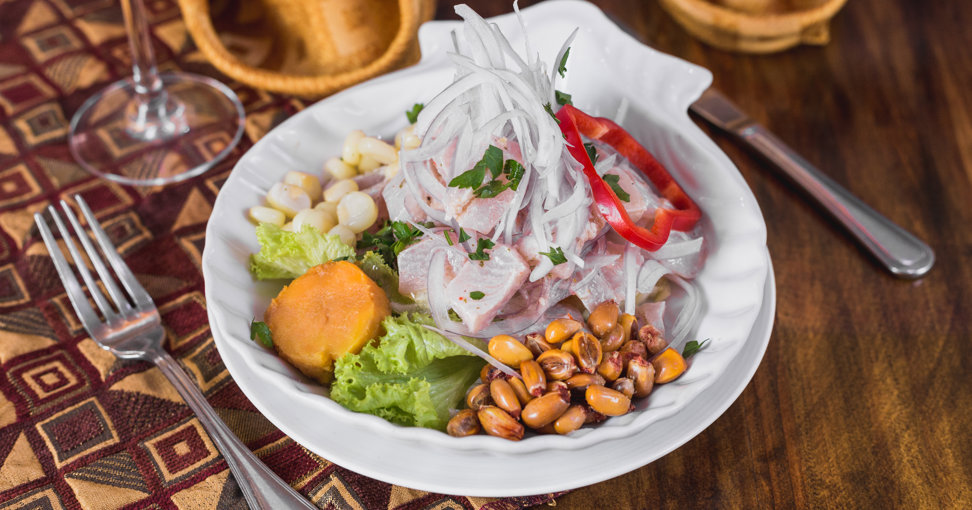Ceviche: the history and recipe of peru’s signature raw fish dish

Ceviche: cultural heritage of Peru
Ceviche is one of the emblematic dishes of Peruvian cuisine, made primarily with raw fish and seafood marinated in lime juice, chili pepper, and onion. Its fresh and vibrant flavor makes it a delight for the most demanding palates, which is why it was declared a Cultural Heritage of the Nation in 2004 and recognized by UNESCO as Intangible Cultural Heritage of Humanity. Although there are variations of ceviche in countries like Mexico and Chile, the Peruvian version stands out for its deep history and cultural richness.
Pre-Inca origins and ancestral tradition
Ceviche has roots that go back to pre-Inca times. The Chimú and Moche cultures, settled along the Peruvian coast, already consumed fresh fish, seafood, and seaweed. The Mochicas prepared fish marinated with tumbo, a local citrus fruit, and native herbs. During the Inca Empire, raw fish was seasoned with chili pepper and chicha de jora, a fermented corn-based beverage.
With the arrival of the Spanish during the Viceroyalty, ceviche began to incorporate sour orange and onion, ingredients that enriched its flavor. By the 20th century, lime became the main acid used to marinate the fish, establishing the modern recipe we know and love today.
Traditional ingredients and side dishes
Peruvian ceviche is traditionally served with sweet potato, choclo (tender corn), and canchita serrana (toasted corn), which provide contrasting textures and flavors. In northern Peru, zarandaja—a type of bean—is added, giving the dish a distinctive regional touch. Sweet potato, which can be yellow, purple, or white, has been a staple food since ancient times and remains essential to this dish.
Peru’s coastline is rich in marine resources, with around 800 varieties of fish and 400 types of seafood available for ceviche. Rivers and lakes in the region also provide shrimp and trout, which are used in some local recipes.
Leche de tigre: the soul of ceviche
A highly appreciated element of ceviche is its juice, popularly known as "Leche de Tigre" (Tiger’s Milk). This flavorful liquid is made with half a fillet of white fish, red onion, and the juice of five limes, all blended together and served as a potent and delicious complement. Leche de Tigre is famous for its intense flavor and is consumed both as part of ceviche and as a drink.
Regional variations of Peruvian ceviche
Peruvian ceviche varies across regions, adapting to local ingredients and tastes. In the central coast, especially Lima, ceviche is typically served with sweet potato, corn, and toasted corn. In the northern coast, such as Piura and Tumbes, it is common to include zarandaja, and fattier fish like corvina (sea bass) are often used. In the south, such as in Arequipa, some versions include additional seafood and a milder chili. In the Peruvian Amazon, ceviche is made with river fish like doncella, and citrus juices and local jungle herbs are used. These variations enrich the ceviche experience, showcasing Peru’s culinary diversity.
National celebration and recognition
According to the Royal Spanish Academy, ceviche is a traditional dish in several Latin American countries, especially along the coast, made with fish marinated in lime, onion, and chili. In Peru, Ceviche Day is officially celebrated on June 28, just one day before Fisherman's Day, highlighting its importance in national culinary culture and the lives of coastal communities. This date not only honors this iconic dish but also the fishermen who provide its fresh ingredients. In many coastal cities, especially Lima, Piura, and Tumbes, festivals, ceviche competitions, and cultural events are held, bringing together chefs, fishermen, and lovers of Peruvian cuisine to celebrate and promote the country’s marine bounty and culinary diversity.
Corvina ceviche Recipe
(Serves 4)
Ingredients:
- 300 grams of corvina fillet
- Juice of 8 limes
- 1 red ají limo, seeded and finely chopped
- 4 slices of rocoto pepper (for decoration)
- A pinch of white pepper
- Salt to taste
- Side Dishes:
- 2 glazed sweet potatoes
- 1 ear of corn, kernels removed
- 1 red onion, thinly sliced (julienned)
Preparation:
Cut the fish into approximately 2 cm pieces. Add salt, white pepper, lime juice, and ají limo. Let it marinate for about five minutes. Add the julienned red onion (previously rinsed with salt). Mix all ingredients well.
Serve on a plate decorated with slices of glazed sweet potato, corn kernels, and slices of rocoto.
Note: Fish and seafood must be fresh, not frozen.
SOURCES:
Cocina Peruana: Historia, Cultura y Sabores, Autor: Sara Beatriz Guardia. USMP